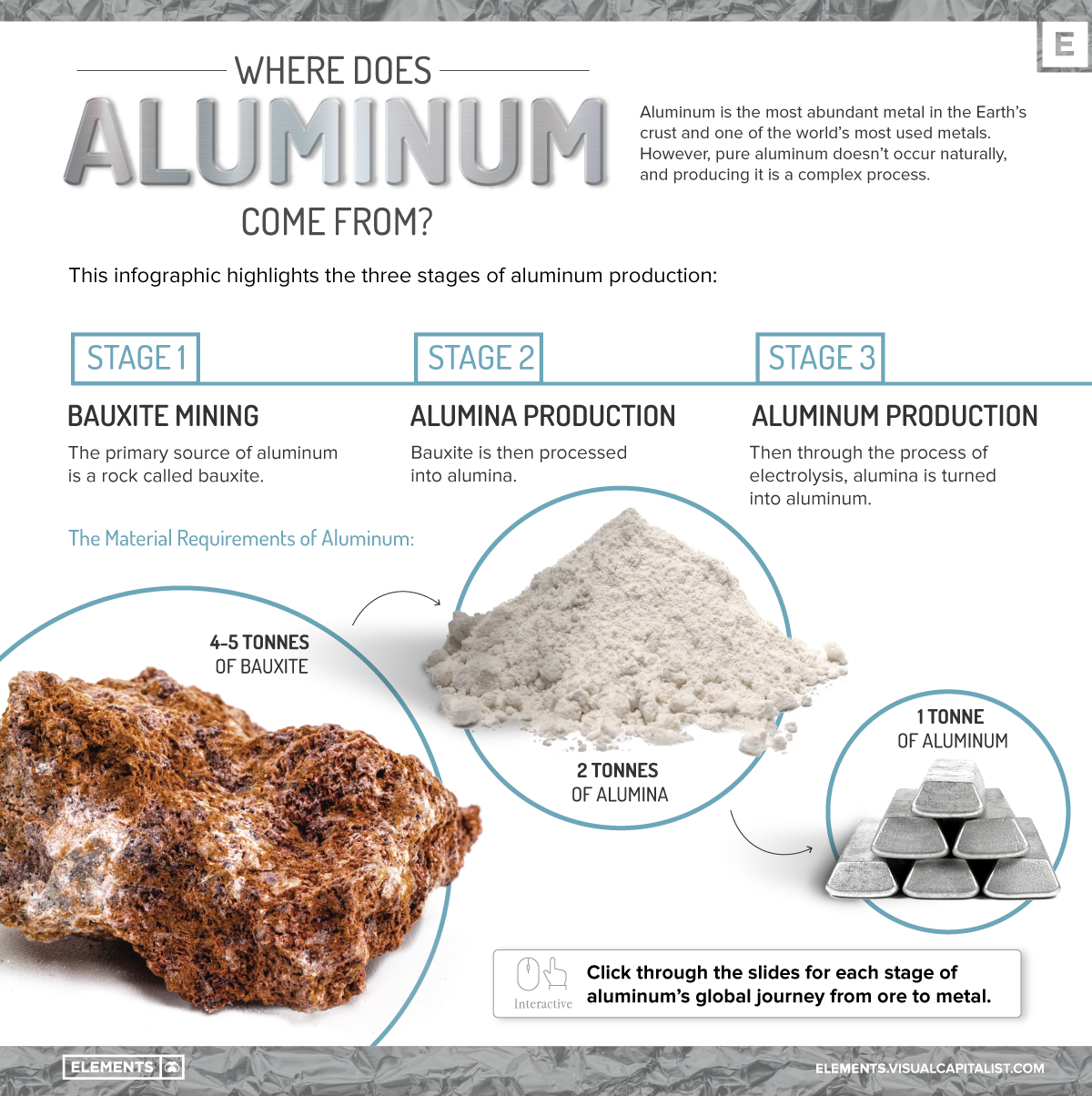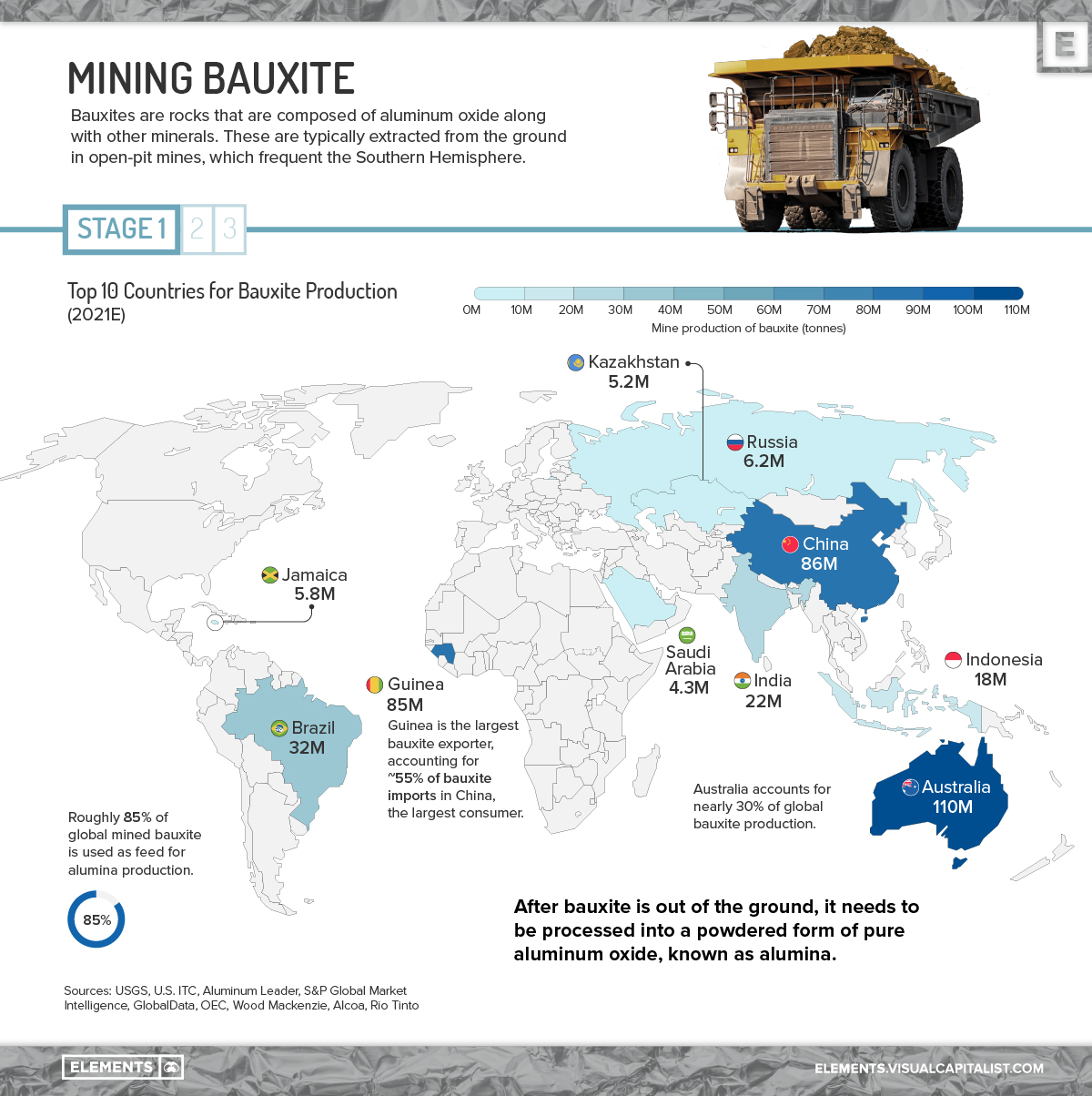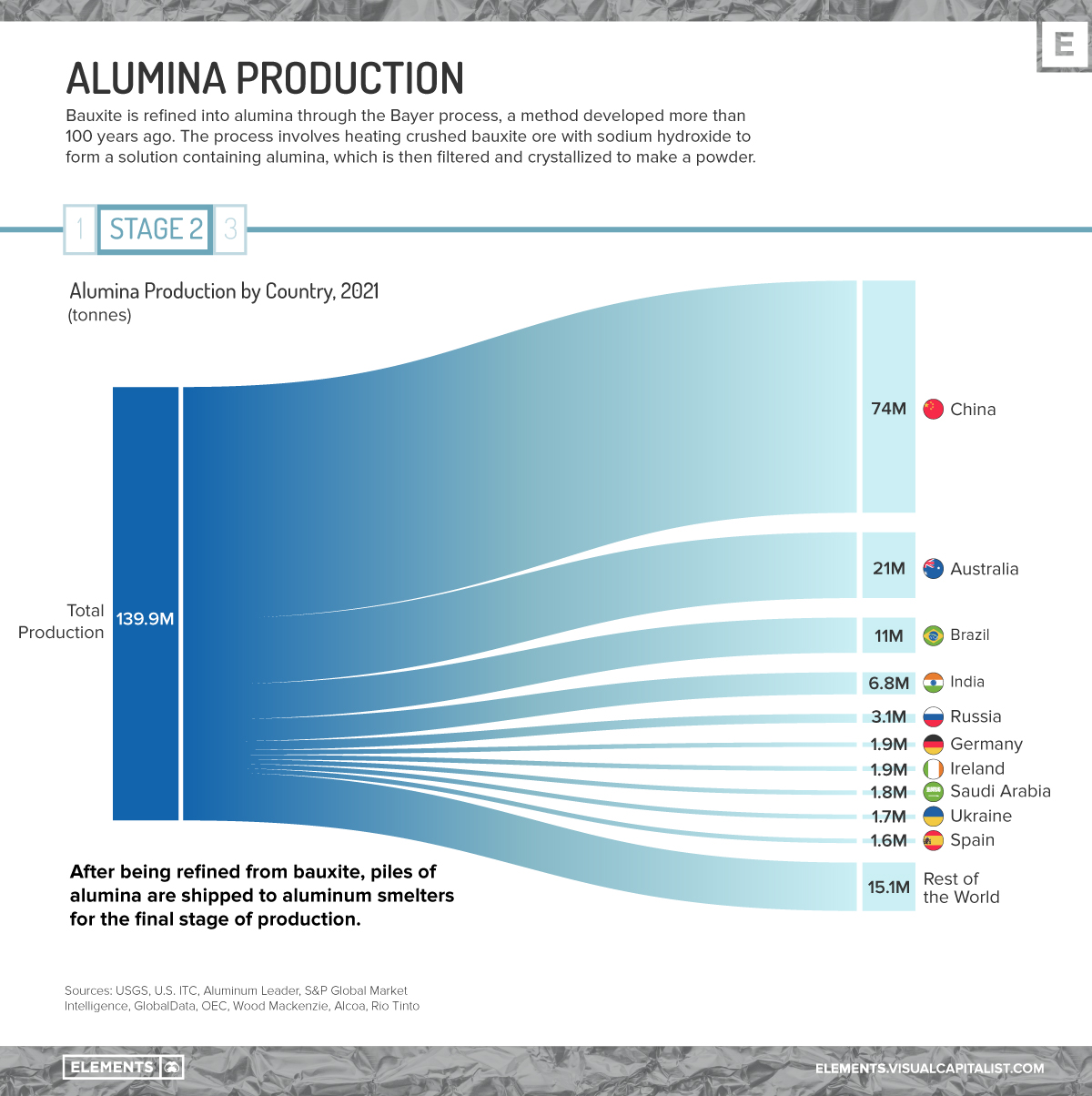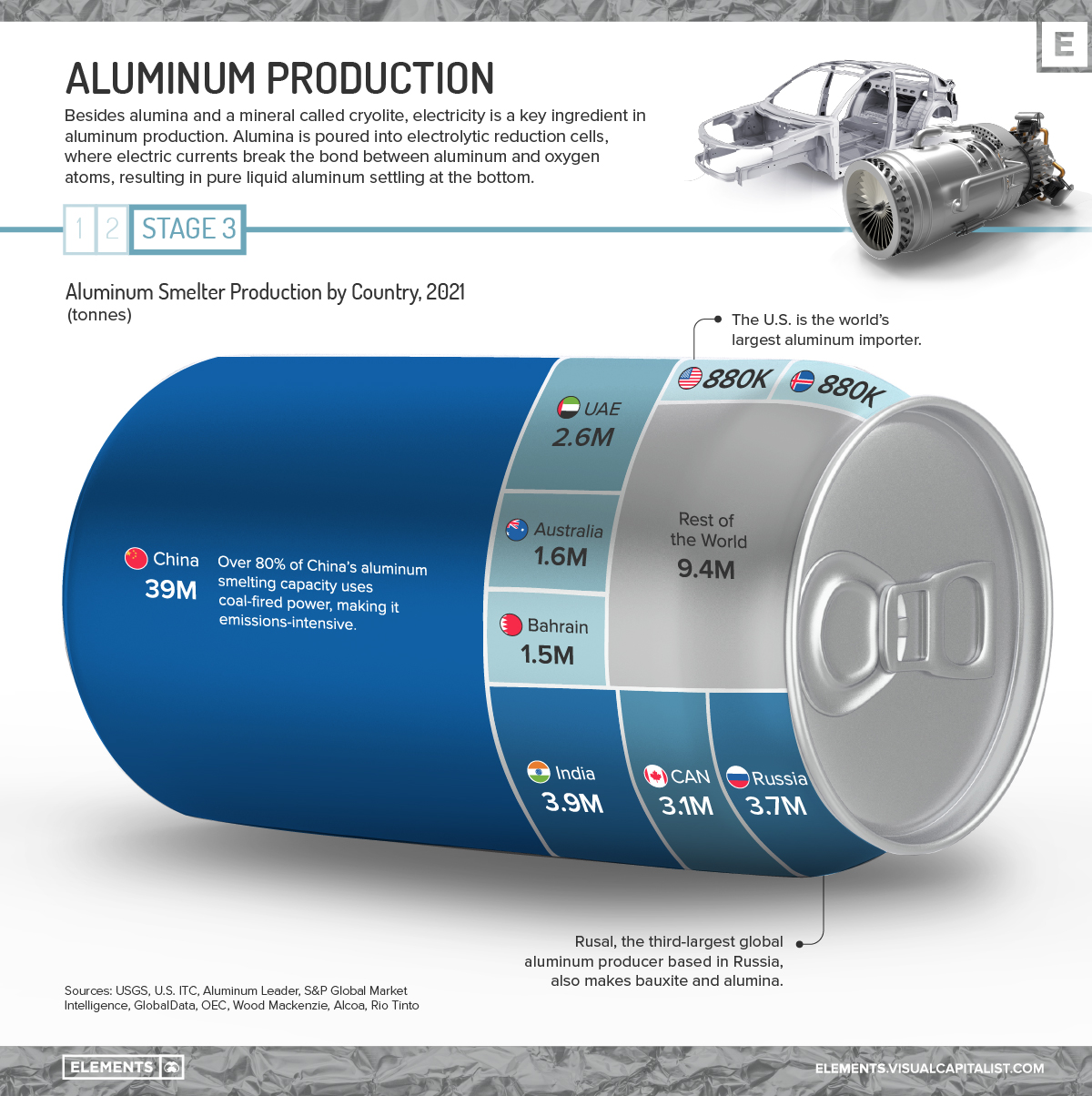Misc
How Is Aluminum Made?
How to Use: Click the arrows on the right to see the next stage of aluminum production.
How is Aluminum Made?
Aluminum is one of our most widely-used metals, found in everything from beer cans to airplane parts.
However, the lightweight metal doesn’t occur naturally, and producing it is a complex process.
The above infographics use data from the USGS, Aluminium Leader, and other sources to break down the three stages of aluminum production.
The Three Stages of Aluminum Production
Each year, the world produces around 390 million tonnes of bauxite rock, and 85% of it is used to make aluminum.
Bauxites are rocks composed of aluminum oxides along with other minerals and are the world’s primary source of aluminum. After mining, bauxite is refined into alumina, which is then converted into aluminum.
Therefore, aluminum typically goes from ore to metal in three stages.
Stage 1: Mining Bauxite
Bauxite is typically extracted from the ground in open-pit mines, with just three countries—Australia, China, and Guinea—accounting for 72% of global mine production.
| Country | 2021 Mine Production of Bauxite (tonnes) | % of Total |
|---|---|---|
| Australia 🇦🇺 | 110,000,000 | 28.2% |
| China 🇨🇳 | 86,000,000 | 22.1% |
| Guinea 🇬🇳 | 85,000,000 | 21.8% |
| Brazil 🇧🇷 | 32,000,000 | 8.2% |
| India 🇮🇳 | 22,000,000 | 5.6% |
| Indonesia 🇮🇩 | 18,000,000 | 4.6% |
| Russia 🇷🇺 | 6,200,000 | 1.6% |
| Jamaica 🇯🇲 | 5,800,000 | 1.5% |
| Kazakhstan 🇰🇿 | 5,200,000 | 1.3% |
| Saudi Arabia 🇸🇦 | 4,300,000 | 1.1% |
| Rest of the World 🌍 | 15,500,000 | 4.0% |
| Total | 390,000,000 | 100.0% |
Australia is by far the largest bauxite producer, and it’s also home to the Weipa Mine, the biggest bauxite mining operation globally.
Guinea, the third-largest producer, is endowed with more than seven billion tonnes of bauxite reserves, more than any other country. Additionally, Guinea is the top exporter of bauxite globally, with 76% of its bauxite exports going to China.
After bauxite is out of the ground, it is sent to refineries across the globe to make alumina, marking the second stage of the production process.
Stage 2: Alumina Production
In the 1890s, Austrian chemist Carl Josef Bayer invented a revolutionary process for extracting alumina from bauxite. Today—over 100 years later—some 90% of alumina refineries still use the Bayer process to refine bauxite.
Here are the four key steps in the Bayer process:
- Digestion:
Bauxite is mixed with sodium hydroxide and heated under pressure. At this stage, the sodium hydroxide selectively dissolves aluminum oxide from the bauxite, leaving behind other minerals as impurities. - Filtration:
Impurities are separated and filtered from the solution, forming a residue known as red mud. After discarding the mud, aluminum oxide is converted into sodium aluminate. - Precipitation:
The sodium aluminate solution is cooled and precipitated into a solid, crystallized form of aluminum hydroxide. - Calcination:
The aluminum hydroxide crystals are washed and heated in calciners to form pure aluminum oxide—a sandy white material known as alumina.
The impurities or red mud left behind in the alumina production process is a major environmental concern. In fact, for every tonne of alumina, refineries produce 1.2 tonnes of red mud, and there are over three billion tonnes of it stored in the world today.
China, the second-largest producer and largest importer of bauxite, supplies more than half of the world’s alumina.
| Country | 2021 alumina production (tonnes) | % of total |
|---|---|---|
| China 🇨🇳 | 74,000,000 | 53% |
| Australia 🇦🇺 | 21,000,000 | 15% |
| Brazil 🇧🇷 | 11,000,000 | 8% |
| India 🇮🇳 | 6,800,000 | 5% |
| Russia 🇷🇺 | 3,100,000 | 2% |
| Germany 🇩🇪 | 1,900,000 | 1% |
| Ireland 🇮🇪 | 1,900,000 | 1% |
| Saudi Arabia 🇸🇦 | 1,800,000 | 1% |
| Ukraine 🇺🇦 | 1,700,000 | 1% |
| Spain 🇪🇸 | 1,600,000 | 1% |
| Rest of the World 🌍 | 15,100,000 | 11% |
| Total | 139,900,000 | 100% |
Several major producers of bauxite, including Australia, Brazil, and India, are among the largest alumina producers, although none come close to China.
Alumina has applications in multiple industries, including plastics, cosmetics, and chemical production. But of course, the majority of it is shipped to smelters to make aluminum.
Stage 3: Aluminum Production
Alumina is converted into aluminum through electrolytic reduction. Besides alumina itself, another mineral called cryolite is key to the process, along with loads of electricity. Here’s a simplified overview of how aluminum smelting works:
- In aluminum smelter facilities, hundreds of electrolytic reduction cells are filled up with molten cryolite.
- Alumina (composed of two aluminum atoms and three oxygen atoms) is then dumped into these cells, and a strong electric current breaks the chemical bond between aluminum and oxygen atoms.
- The electrolysis results in pure liquid aluminum settling at the bottom of the cell, which is then purified and cast into its various shapes and sizes.
China dominates global aluminum production and is also the largest consumer. Its neighbor India is the second-largest producer, making only a tenth of China’s output.
| Country | 2021 Aluminum Smelter Production (tonnes) | % of total |
|---|---|---|
| China 🇨🇳 | 39,000,000 | 59% |
| India 🇮🇳 | 3,900,000 | 6% |
| Russia 🇷🇺 | 3,700,000 | 6% |
| Canada 🇨🇦 | 3,100,000 | 5% |
| United Arab Emirates 🇦🇪 | 2,600,000 | 4% |
| Australia 🇦🇺 | 1,600,000 | 2% |
| Bahrain 🇧🇭 | 1,500,000 | 2% |
| Iceland 🇮🇸 | 880,000 | 1% |
| U.S. 🇺🇸 | 880,000 | 1% |
| Rest of the World 🌍 | 9,400,000 | 14% |
| Total | 66,560,000 | 100% |
As is the case for alumina production, some of the countries that produce bauxite and alumina also produce aluminum, such as India, Australia, and Russia.
Roughly a quarter of annually produced aluminum is used by the construction industry. Another 23% goes into vehicle frames, wires, wheels, and other parts of the transportation industry. Aluminum foil, cans, and packaging also make up another major end-use with a 17% consumption share.
Aluminum’s widespread applications have made it one of the most valuable metal markets. In 2021, the global aluminum market was valued at around $245.7 billion, and as consumption grows, it’s projected to nearly double in size to $498.5 billion by 2030.
Misc
Visualizing Global Aluminum Production
China dominates global production with nearly 60% share.
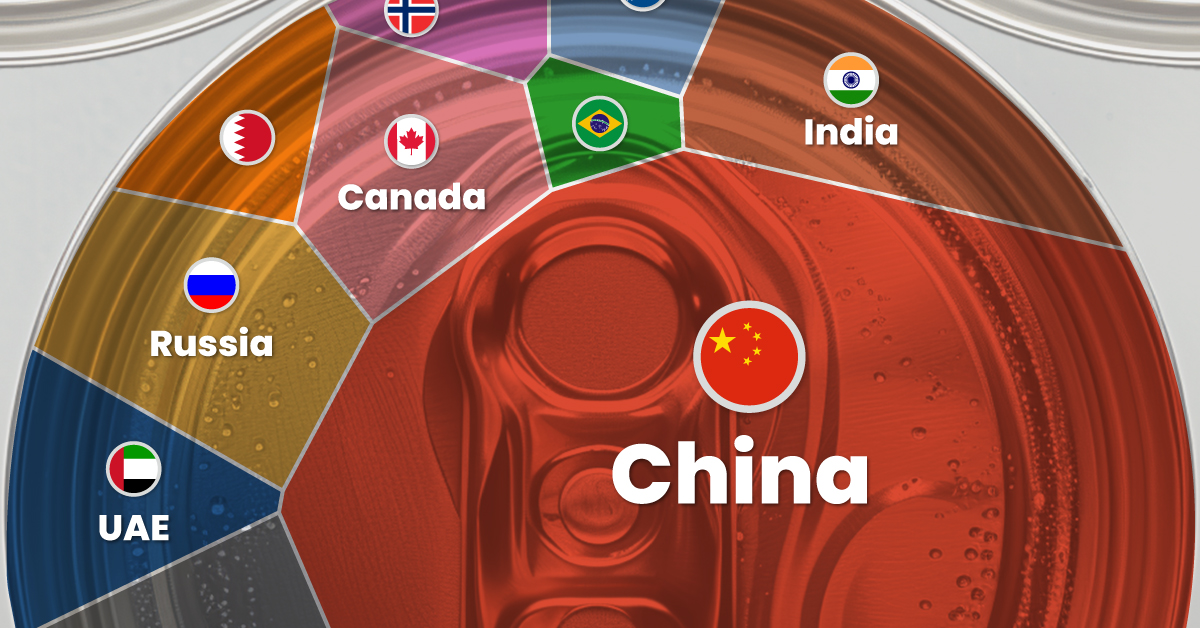
Visualizing Global Aluminum Production
This was originally posted on our Voronoi app. Download the app for free on iOS or Android and discover incredible data-driven charts from a variety of trusted sources.
This infographic shows estimated aluminum smelter production by country in 2023, based on data from the most recent U.S. Geological Survey (USGS) Mineral Commodity Summaries, published in January 2024 .
From this data, we can see that China leads as the top producer, accounting for nearly 60% of the world’s smelter capacity. Its neighbor India is the second-largest producer, making only a tenth of China’s output.
| Country | 2023 Aluminum Smelter Production (tonnes) | % of total |
|---|---|---|
| 🇨🇳 China | 41,000,000 | 59% |
| 🇮🇳 India | 4,100,000 | 6% |
| 🇷🇺 Russia | 3,800,000 | 5% |
| 🇨🇦 Canada | 3,000,000 | 4% |
| 🇦🇪 United Arab Emirates | 2,700,000 | 4% |
| 🇧🇭 Bahrain | 1,600,000 | 2% |
| 🇦🇺 Australia | 1,500,000 | 2% |
| 🇳🇴 Norway | 1,300,000 | 2% |
| 🇧🇷 Brazil | 1,100,000 | 2% |
| 🌍 Rest of the World | 9,460,000 | 14% |
| Total | 69,560,000 | 100% |
Responsible for 5% of global aluminum output, Russia has been targeted by recent sanctions from the U.S. and the UK.
The sanctions include prohibiting metal-trading exchanges from accepting new aluminum produced by Russia and barring the import of the Russian metal into the U.S. and Britain. The actions are aimed at disrupting Russian export revenue amid Moscow’s ongoing invasion of Ukraine.
The World’s Most Common Metal
Aluminum is the primary material used for making cans, foil, and many other products. It originates from bauxites, rocks composed of aluminum oxides, and various minerals.
Approximately 25% of annually produced aluminum is utilized by the construction industry, while another 23% is allocated to vehicle frames, wires, wheels, and other components within the transportation sector. Aluminum foil, cans, and packaging constitute another significant end-use category, accounting for 17% of consumption.
Despite its extensive use, aluminum is still plentiful. Aluminum is the world’s most common metal by crustal abundance, making up 8.2% of the Earth’s crust.
According to the USGS, global resources of bauxite are estimated to be between 55 billion and 75 billion tonnes and are sufficient to meet world demand for metal well into the future.
Misc
Brass Rods: The Sustainable Choice
Brass rods can help cut emissions in machine shops, be recycled without losing properties, and contribute to a cleaner environment.

Brass Rods: The Sustainable Choice
Brass rods have a powerful lineup of green attributes, making them the sustainable choice for manufacturers and end-users of precision machined and forged parts.
This infographic, from the Copper Development Association, shows how brass rods can reduce emissions in machine shops, be recycled without losing properties, and contribute to a cleaner environment.
The Brass Rod Circular Economy
The metallurgical properties of brass allow pre- and post-consumer sources of brass scrap to be recycled with no loss in properties.
Brass scrap can retain over 90% of the original material value. In addition, brass doesn’t need energy-intensive processing, unlike steel and aluminum, which must be smelted and refined before being recycled into new products.
As a result, there is a greater chance that steel and aluminum scrap will end up in landfills.
Most brass-rod alloys produced in North America contain 95% or higher recycled content.
Closed-loop recycling of brass keeps this valuable engineering material out of landfills, reducing the need for new mines and all the environmental impacts that entails.
Higher Machinability Leads to Lower Operational Carbon Emissions
Machinability is how easily a material can be worked using cutting processes. It directly impacts the amount of energy required to produce finished parts.
With typical machine shops producing millions of parts each year, the carbon impact can be significant.
Here’s how brass and steel compare when manufacturing complex parts using computer numerical control (CNC) machining.
| Material | Brass | Steel |
|---|---|---|
| Type | Free-cutting brass (C36000) | Free-cutting steel (12L14) |
| Maximum machinability rating (0-100) | 100 | 21 |
| Metal Removal Rate (cubic inches per minute) | 0.238 | 0.114 |
| Time to remove material (hours) | 161,111 | 336,111 |
| Energy required to produce parts (kilowatt-hour) | 9,475 | 18,931 |
In this example, using brass represented a savings of 3,510 kg in carbon dioxide (CO2).
The significantly longer tool life enabled by brass also reduces the need for new cutting tools, further decreasing emissions.
High recycled content and exceptional machinability make brass rods the sustainable choice for manufacturers and end-users seeking to reduce their environmental footprint and support the transition to a low-carbon future.
Explore the advantages of brass rod solutions.
-

 Electrification3 years ago
Electrification3 years agoRanked: The Top 10 EV Battery Manufacturers
-

 Electrification2 years ago
Electrification2 years agoThe Key Minerals in an EV Battery
-

 Real Assets3 years ago
Real Assets3 years agoThe World’s Top 10 Gold Mining Companies
-

 Misc3 years ago
Misc3 years agoAll the Metals We Mined in One Visualization
-

 Electrification2 years ago
Electrification2 years agoMapped: Solar Power by Country in 2021
-

 Energy Shift2 years ago
Energy Shift2 years agoWhat Are the Five Major Types of Renewable Energy?
-

 Electrification2 years ago
Electrification2 years agoThe World’s Largest Nickel Mining Companies
-
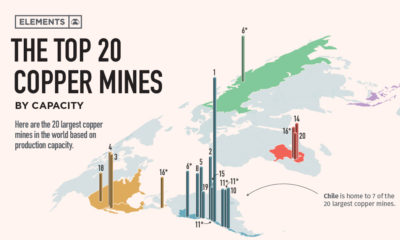
 Misc3 years ago
Misc3 years agoThe Largest Copper Mines in the World by Capacity






